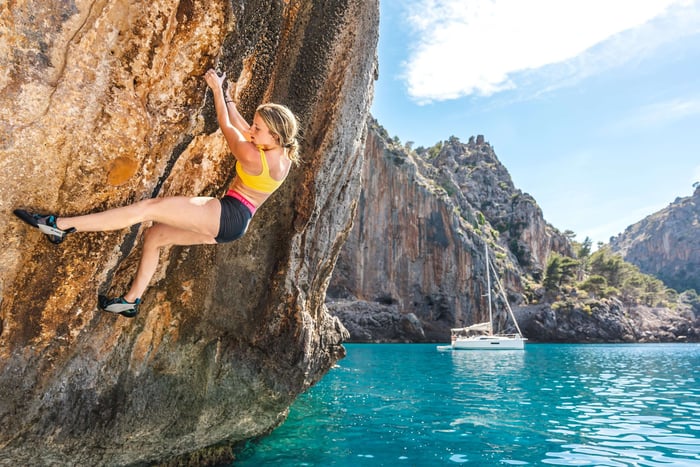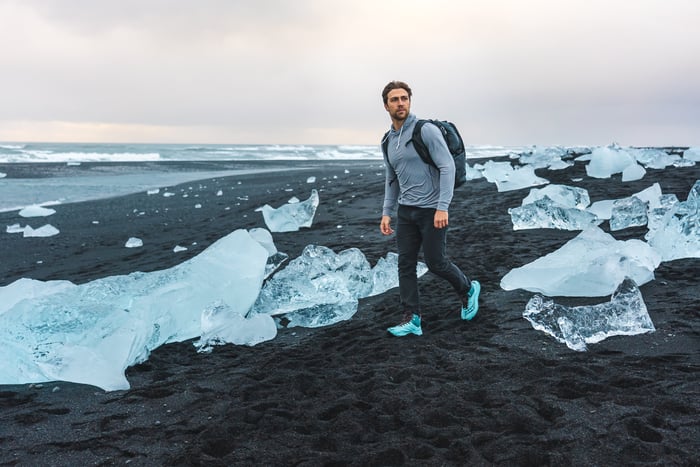Robert is a New York based director, DP, photographer and drone pilot who has spent nearly a decade filming and photographing some of the world’s most recognizable brands, artists and athletes. A former engineer, Robert brings a unique perspective to the creative process and his versatility as a creator has helped him excel in a variety of roles and environments while working on TV sets, documentary crews, and commercial shoots. An avid traveler, outdoorsman, and lifelong athlete, Robert has made a career out of shooting and thriving in unforgiving conditions.
For those that don’t know you, what do you do?
I’m a director, DP and editor for travel, fashion and outdoor adventure brands and documentaries.
How did you get started on this path? What was some of your early influence or inspiration?
I first picked up a camera when I realized I no longer wanted to be a mechanical engineer. It was the early age of travel influencers on Instagram and my interest in climbing had also led me to discover the work of guys like Jimmy Chin and Chris Burkard. Shortly afterwards my now wife and I backpacked around the world for 5 months, and during that time I taught myself as much as I could about shooting and editing through YouTube. The more I shot, the more I learned and slowly but surely I built a portfolio that was worthy of attracting commercial clients. One project led to another and eventually I had just enough income from photography and videography to convince myself that I could make it work.
 You travel a lot- how often are you on the road? Is it always for work?
You travel a lot- how often are you on the road? Is it always for work?
This year has been absolutely insane when it comes to traveling. From January to August I was never in New York for longer than a week. Since my early work was rooted in the travel, adventure, and hospitality spaces, a lot of my work lends itself to location driven shoots and I’ve become very efficient at working out of a camera bag and a suitcase to produce what my clients need. Aside from my countless shoots in California this year, I was fortunate enough to help film a documentary in Peru and shoot content for Mini in Rotterdam this year. On top of my work schedule, travel is still a huge part of my wife and I’s personal lives and I also tend to take a few rock climbing trips each year, including a 24 hour climbing competition down in Jasper, Arkansas every September.
Can you talk about the relationship between travel and image making, and how that has influenced your career?
One aspect of traveling that I’ve always found appealing is how often you find yourself in unique situations and experiencing people, places and things you wouldn’t otherwise encounter in your everyday life. I think photography is similar in that no matter the scenario, no two people will take the same image even if they’re sharing the same experience. Photography is all about preserving a specific moment in time and when we travel, we’re often forced out of our comfort zone in a way that encourages us to be present and truly focus on what’s in front of us. When we capture those moments with a camera, it can be a portal back in time to those specific memories.
 Do you have a favorite type of subject?
Do you have a favorite type of subject?
I’m typically less interested in the type of subject and more interested in the type of shoot. I love working in situations and environments that challenge me physically and mentally to pull off the creative vision. If I had to choose one type of subject I’d say shooting people immersed in extraordinary outdoor locations, such as a model on the side of a mountain at sunset or a climber scaling an overhanging cliff above the ocean.
Can you touch on some of your career highlights? What would you ultimately like to accomplish with your work?
Some of my favorite moments in my career have been the times where I’m hired to film things that I would already want to be doing, such as shooting for a group travel company in New Zealand two weeks before I had my own vacation to New Zealand planned or filming a soccer match between Ronaldinho and Kaká who were two of my favorite players to watch growing up. My highlight from this year was being one of the camera operators on an amazing documentary project in Peru about ceviche. Ultimately my biggest goal with my work is to eventually work on projects that tell meaningful stories and inspire people to go out and experience more of the world. I’m working on a climbing documentary in Mexico soon that will certainly fit this build, but I believe this can also apply to my commercial work and I’m always striving to push myself in this capacity.
How do you stay inspired and motivated creatively?
Variety is a huge driver in my creative inspiration. One of the main reasons I left my engineering career was because of the monotony I was already experiencing at such an early stage. Choosing to direct, film, photograph and edit instead of specializing in only one or two areas allows me to experience so many different sides of the creative process that keep me motivated and make my work that much more dynamic.
Can you tell us about a project that was particularly challenging? How did you overcome those obstacles?
Any project that’s worthwhile is challenging in some capacity and I’ve always said that good photographers and filmmakers separate themselves by their ability to handle whatever problems inevitably arise during a shoot. One of my recent projects involved a location with an approach down the side of a cliff to a secluded beach that was supposed to have a rope ladder down to it that had somehow disappeared between the scouting day and the shoot. Since I’m a climber I’m fairly comfortable in that terrain so I helped carry a lot of the equipment, but getting all of the gear, the talent and the rest of the crew down to the beach took a bit longer than we had originally planned for. With the daylight now fading fast, we quickly adjusted our shotlists on the fly to ensure that we’d be able to shoot everything our client needed before sunset.
You’re a podcast host as well, how does that fit with your imagemaking?
My good friend and I host The Ground Up Podcast where we interview local legends from various climbing communities around the country. There are some obvious similarities to filmmaking and podcasting when you think about on-camera interviews, but more generally the podcast has been a fun way to practice the art of storytelling through a different medium. I think it’s also helped inform my work a bit because we often have to discover parts of the story as we go through an interview and as a result I find myself looking for potential story lines when I’m filming more oft en than I used to.
en than I used to.
How has technology affected your career? Does anything in particular excite you about where technology's going right now?
Technology has been a massive enabler in my career. From first learning the necessary skills on YouTube, to relying heavily on the digital nature of today’s cameras to get valuable repetitions in, I don’t think I would have been able to progress to the point I am at in my career as quickly as I have if the technology was not as good as it is. Storage and data management is a huge part of this since I can easily travel with so many different files and types of projects with me while I’m shooting different projects. AI is a huge topic in the creative world right now as its applications for our work are progressing at such a rapid pace, but it’s honestly not a direction I’m particularly excited about. For me the most exciting aspect of technology in this space is still how much brands are continuing to improve on the form vs function ratio of cameras and what that allows us to pull off.
What is your workflow when you’re on the go, to ensure you keep all your data and gear (and yourself) safe?
I think some of my colleagues would be horrified to hear how simple, some might even say archaic, my workflow is when it comes to data management, but it’s what works for me and my schedule. With the number of flights that I have and remote locations I find myself in, it’s kind of vital for me to not only be able to edit on a plane, but also be able to work in situations where I don’t have access to wifi. For that reason, I don’t rely on cloud storage, but instead prefer to work off of individual SSD’s with larger backup harddrives that I keep at home.
Can you tell us about a time that having a data management strategy prevented you from losing important work?
There are plenty of times that a data management strategy has helped me preserve my work, but I think a more important lesson is the time my lack of a data management strategy made me lose my work. When I was just getting started, I had all of my work on a single hard drive. One night when I was editing, I accidentally knocked it off from where it was resting. The drive unplugged from my computer and hit the ground, losing all of the photos and footage I had shot on that trip. Ever since that moment, I’ve taken much greater care of my drives and put more thought into having an effective data management strategy that relies on redundancy to eliminate any potential problems before they happen. Simple things like backing up my files on multiple drives or simultaneously recording on two memory cards go a long way now.

What are the three ‘must haves’ for every filmmaker/photographer?
Every filmmaker and photographer needs a camera, creative problem solving skills and trust in their creative vision.
If you could go back in time and give your younger self advice when you were first starting out your career, what would you say?
The advice I’d give my younger self would be to start shooting sooner and more often, learn from others as much as you can, and always have fun while you work.
What are you working on currently or have coming up that’s exciting?
The project I’m currently most excited about is a climbing documentary in Mexico that we’re filming in February. I can’t say much more about it yet, but it’s always special getting to combine my professional and personal passions.
What’s the best way for people to connect with you?
Instagram: @Robert_Lib
Email: Robert@Libtography.com





